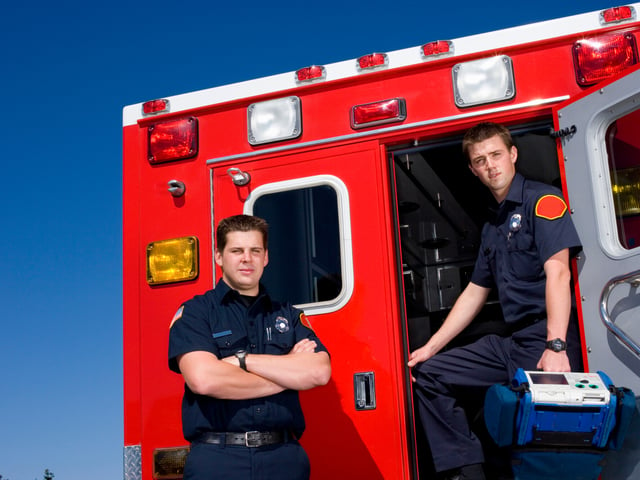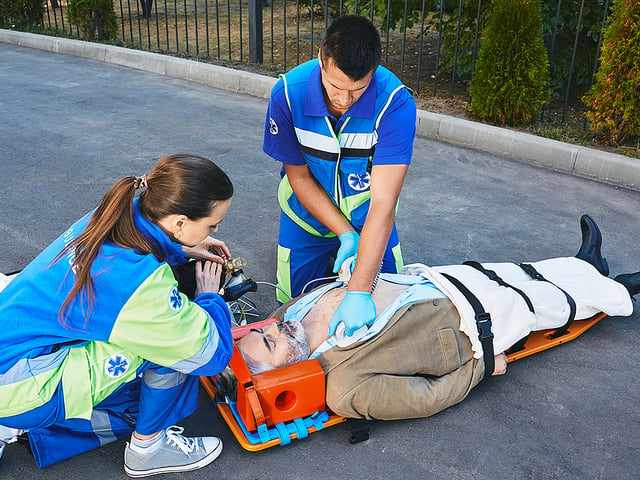
What Is a Passing Score on the NREMT Exam?
The job outlook for EMTs and paramedics is strong. The Bureau of Labor predicts that the demand for this type of service will grow by 7% in the coming decade. If working in the life-saving field of emergency medical technicians calls you, now is the time to get started.
Unlike doctors, nurses, and surgeons, EMTs don’t have to undergo years of expensive education. However, they must study, take an accredited EMT course, and pass the NREMT exam.
What is a passing score on the NREMT exam? What questions are included on the NREMT exam, and how can you prepare?
Read on to learn everything you need to know about getting a passing score on the NREMT exam and receiving your EMT certification.
What Is the NREMT Exam?
The National Registry of Emergency Medical Technicians (NREMT) is an organization designed to ensure that the nation’s EMTs are proficient in both the knowledge and technical skills needed to provide emergency care as patients are escorted to the hospital. The NREMT has developed four certifications for emergency medical workers, including EMT certification.
The cost to take the NREMT exam is $70. You will also have to pay additional fees to complete your courses, and many students pay for extra study materials to increase their chances of passing the exam.
How Is the NREMT Exam for EMTs Structured?
The NREMT exam for EMTs is divided into two tests: the cognitive test and the psychomotor test. The cognitive test consists of 70 to 120 questions you take on a computer at an NREMT-approved facility. The psychomotor test consists of several “scenarios” that the student must assess in the proper order and can be taken at either your State EMS Office or your training institution.
Today, we’re focusing on the cognitive test, which you will need to pass before moving on to the psychomotor test. The cognitive test consists of content areas, sections, and competencies.
Content Areas
The broader structure of the NREMT exam is broken down into six content areas. These content areas cover the basic medical procedures EMTs must know how to navigate, including airway management and resuscitation. You must complete each content area to move on to the next, which is to say that you can’t skip questions and come back to them later.
Sections
Content areas are broken down into sections. These sections are the primary topics within each content area that EMTs must master. They include things like psychiatric health, respiratory failure, and bleeding.
Competencies
Finally, sections are broken down into competencies. Competencies refer to the skills and knowledge needed to address each section. You will be given a situation and four possible answers that would properly address the scenario; the entire cognitive test is multiple-choice.
A Breakdown of the NREMT Exam
Now that you understand the NREMT exam’s basic structure, let’s take a closer look at the subject matter. Read on as we list the sections in each content area and the number of competencies you may have to answer. Remember that if you answer competencies incorrectly, you will have to answer more of them.
Airway Management, Respiration, and Artificial Ventilation
This content area is divided into three sections:
-
airway management
-
respiration
-
artificial ventilation
There are 11 competencies across these three sections.
Medicine
This content area is divided into 15 sections:
-
medical overview
-
neurology
-
abdominal and gastrointestinal issues
-
immunology
-
endocrine disorders
-
infectious diseases
-
psychiatric disorders
-
cardiovascular health
-
toxicology
-
respiratory issues
-
hematology
-
genitourinary/renal issues
-
gynecology
-
non-traumatic musculoskeletal issues
-
eye, ear, nose, and throat diseases
There are 61 competencies across these 15 sections.
Shock and Resuscitation
This content area is a little bit different. Rather than sections and competencies, you will have to complete two sections. First, you will need to identify the symptoms, causes, and treatments for:
-
shock
-
respiratory arrest or failure
-
cardiac arrest or failure
Next, you will need to identify the best post-resuscitation procedures for each category.
Trauma
This content area is divided into 11 sections:
-
trauma overview
-
bleeding
-
chest trauma
-
abdominal and genitourinary trauma
-
orthopedic trauma
-
soft trauma
-
trauma to the head, face, neck, and spine
-
nervous system trauma
-
special considerations in trauma
-
multi-system trauma
-
environmental emergencies
There are 58 competencies across these 11 sections.
Special Patient Populations
This content area is divided into five sections:
-
obstetrics
-
neonatal care
-
pediatrics
-
geriatrics
-
patients with special challenges and disabilities
There are 39 competencies across these five sections.
EMS Operations
This content area is divided into six sections:
-
principles of safe operation of a ground ambulance
-
incident management
-
multiple casualties
-
vehicle extrication
-
awareness of hazardous materials
-
mass casualties
There are 14 competencies across these six sections.
What Is a Passing Score on the NREMT Exam?
NREMT exam scoring is more complicated than you might think. As we mentioned earlier, not all students will receive the same number of questions, as the exam generates more competencies for students who have selected incorrect answers. The questions are weighted, which means that harder questions are worth more points.
Having to answer more competencies isn’t a bad thing. The purpose of this structure is to give students who are struggling with the exam more opportunities to demonstrate their knowledge.
No matter how many questions you have to answer on the cognitive test, you will need a score of at least 70% to pass the NREMT. Students often strive for a higher score, but 70% will get you through the first round so that you can take the psychomotor test and receive EMT certification.
What Happens if You Fail the NREMT Exam?
The pass rate for the NREMT exam is hard to calculate, as it seems to vary based on where you live and where you take your EMT certification courses. That said, failing the first time around isn’t all that uncommon. Many states have somewhere between a 60-70% pass rate on the first try, which means that about one-third of students have to take the exam at least twice.
If you do fail the first time around, don’t sweat it. You can take the test up to three times before you will have to enroll in a remedial training course. After that, you can take the test three more times again, re-enrolling in your EMT training course if you don’t pass the test after six attempts.
How Can You Prepare for the NREMT Exam?
Taking an EMT training course is required to take the NREMT exam. However, taking that training course isn’t the only thing that you should do before taking the actual exam. Let’s take a look at some key ways to prepare and improve your chances of passing the first time.
Study Up
Make sure to take thorough notes during your training courses and review them before your exam. You can also find free study guides and other study materials like flashcards and lessons. Use these materials to create a schedule, spending a few hours each day studying the different content areas and their various sections.
Remember, there are better ways to tap into your memory than cramming right before the test. Instead, start studying several weeks before the exam and spend the day before your exam relaxing. By starting early, you give yourself plenty of time to learn the material you’re struggling with the most.
Take NREMT Practice Tests
How can you put your knowledge to the test before taking the actual test? Take advantage of free practice tests online. Consider taking an NREMT practice test at least twice before your exam date.
Why are practice tests helpful? They allow you to find out which sections you’ve already mastered and which sections are going to require some more effort. Taking practice tests and noting your strengths and weaknesses can inform how you set up your study schedule.
Plus, practice exams can give you a better sense of the overall structure of the NREMT exam and what kinds of questions you’ll encounter. Students often make the mistake of selecting the choice that sounds most sophisticated or misinterpret what the competencies are asking, and practice exams can help you get the hang of what answers the NREMT is looking for.
Let Us Help You Pass the NREMT With Flying Colors
If you’re thinking of becoming an EMT, you’ll need to get a passing score on the NREMT exam. In addition to completing your coursework, you’ll want to develop a rigorous study schedule to prepare. We’re here to help.
Union Test Prep offers a variety of free NREMT test prep materials that you can access online. Take a look at the study materials we offer for EMT students and create your account today.
Keep Reading

Emergency Medical Technician Test Blog
How Many Questions are on the NREMT?
The National Registry of Emergency Medical Technicians (NREMT) exam is …

Emergency Medical Technician Test Blog
How Hard is the EMT Test?
EMTs (Emergency Medical Technicians) are required to have strong medica…

Emergency Medical Technician Test Blog
How to Pass the NREMT on the First Try
There are many great reasons to become an Emergency Medical Technician …